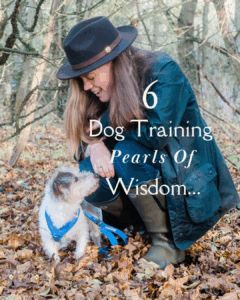
Over the years, I’ve had the privilege of working with so many fabulous dogs and their wonderful humans. And while every dog is different, with their own struggles, there are a few guiding principles I return to time and time again. “My 6 Pearls of Wisdom”. These little gems can make such a huge difference in your dog training journey, especially when you are navigating life with your dog and unsure of what to do for the best.
Let’s jump in…
🐶1. What a dog rehearses, they become.
Just like us, dogs build habits through repetition. If your dog now barks at everything, chances are that behaviour has been rehearsed over time, until it’s become a habit that has now become instinctive and unconscious.
🐶’I hear a noise and I bark.’🐶
It may have started as a few random, ‘woofs’, and now you are finding they bark at what feels like everything.
Pulling on the lead, jumping up, chasing the cat, counter surfing… these are all habits that have grown stronger through rehearsal.
Here’s the good news: behaviours you love, like relaxing quietly on their bed, can also be built up through repetition. Rehearsing calm is just as powerful. 🐶❤️
And it’s not just our dogs – we can fall into habit loops too. What patterns are you rehearsing daily? And are they habits you love or ones you would love to change?
🐶2. Train for the situation, rather than in the situation.
Imagine taking your dog, who struggles with other dogs, to a busy park and hoping for a fabulous training session. More often than not, that’s a recipe for immense stress – for both of you. 😬
Where your dog rehearses a behaviour matters more than you may realise. Because…when we are in an environment where we feel safe, we are also rehearsing a positive emotional state.❤️
Learning happens best when the brain feels safe, calm and when humans and dogs can emotionally engage with each other.
To start with, look to build easy wins in a quiet and familiar environment.
Give your dog the freedom to learn to ‘walk before they run’.
By giving you and your dog easy wins, your progress will build in confidence and gain momentum.
Allow their new skills to grow and flourish somewhere they can succeed and you both feel safe, so that when you are both ready to go, ‘in the situation’, it’s like water off of a ducks back.
🐶3. Where focus goes, energy flows.
You may have heard the quote by Henry Ford: ‘Whether you think you can, or you think you can’t, you’re right.’
If you believe that either you, your dog or both of you are not capable of achieving your training dreams, then you will unknowingly be holding yourself back. You may say something like, ‘I don’t think we can do that, however we will give it a try’.
Our unconscious mind, whilst incredible, also takes everything literally. The main objective of our unconscious mind, is to keep us safe. If you are thinking you are not capable, your unconscious mind will go along with this and ensure you do not achieve your training dream, ‘to keep you safe’.
With our dogs, their unconscious mind works in the same way. So for example, if your dog is reactive towards other dogs, when they see another dog, they may be telling themselves the story that the other dog is going to jump all over them. Even when the chances are the other dog is behaving calmly, your dog’s unconscious mind believes the story, rather than what they are actually seeing, and reacts in a way to keep them safe. Hence all the barking and lunging that erupts from your dog.
So, let’s look at what you can do to help keep everything positive so you can achieve your training dream.
If you are always saying to your dog,
‘stop pulling’,
‘stop barking’,
‘stop jumping’,
your unconscious mind becomes focused on the words, ‘pulling’, ‘barking’ and ‘jumping’. The unconscious mind is great at ignoring the ‘stop’, and purely focuses on the most important word – the one you want to change. So your unconscious mind hears the word pulling and it will zone in on every opportunity to prove to you that your dog is pulling. It will totally ignore the progress you and your dog are making when you do have moments of calm lead walking.
You can flip this all around though – by changing the language you use to yourself (and out loud when talking with your dog).
When you focus on what you do want, like walking calmly, or a calm and quiet dog and all paws on the ground, your brain becomes more attuned to noticing these opportunities – and so does your dog. Your dog starts to pick up on your calmer, more positive energy too. 🧠💫
Even if you have focused on negativity in the past, you can change this going forward. The more you rehearse positive thoughts, emotions and actions, the stronger your neural pathways become, making it easier to repeat and reinforce your new desirable behaviours.
Next time your dog is pulling, rather than telling them to ‘stop pulling’, have a go at asking for what you do want. So you could say, ‘well done, let’s go this way’, as you change direction and get your dog more focused on you.
This works the same for humans as well. Have you ever wondered why it is that children always carry on making so much noise right after you have told them, ‘stop making so much noise’? Their unconscious mind simply hears the word, ‘noise’, and literally tells them to carry on being noisy. How about asking them what you do want, which is to be a little more quiet. You want their unconscious mind to hear what it is you actually want them to do.
🐶4. Train the dog in front of you.
Some days we feel energised and ready to take on the world and other days, we need rest, peace and understanding. ❤️
Our dog’s are the same. The main difference is that they cannot verbally tell us. So we need to look out for the subtle signs our dogs will be giving us that they need some rest. (Being able to recognise your dog’s bucket here is a game changer).
Our dog’s energy levels, focus and emotional state can all change day to day, just like ours can.
Training is more than simply following a plan. It’s about having the flexibility to meet your dog where they are at any given time and showing them empathy when they need plans to change.
Some days, training might look like a short sniffy ‘walk’ in the garden or a rest day where you stay indoors.
And other days, you and your dog might feel ready to take on the world.
Giving yourself some grace on your own training journey as well is such a fundamental part of your success. ❤️
By focusing on what you can do now, you can let go of what you wanted to do differently.
An area I love to guide owners on is to recognise how full both theirs and their dog’s buckets are.
When you honour yours and your dog’s needs in the moment, you build trust, safety and long term success.✨
🐶5. A happy and calm dog makes great choices.
If your dog is bouncing off the walls with excitement or anxious about their surroundings, are they able to make great choices without your help?
When we are overwhelmed or emotional, clear thinking goes out the window doesn’t it and it’s the same for our dogs.
When we help our dogs feel calm and safe, we are enabling them to make great choices. Even when they are on their own. ❤️
You may be thinking to yourself, ‘I want my dog to still have their fun loving and playful character – will bringing calmness into their lives turn them into a snoozing ploddy dog?’.
You can rest assured, your dog will become a better version of themselves, with so many new traits that you love.
Calmness is not the absence of energy. Calmness is the foundation that helps your dog use their energy wisely.
One of my greatest joys is helping owners bring more calm into their dog’s world. Because from calm… EVERYTHING changes. ❤️🧘♀️🐾
🐶6. Focus on connection over correction.
When you catch your dog doing something you would rather they were not doing, distract them away from that activity and get them rehearsing something you do want them doing.
You will always get more of what you focus on, so if you focus on them doing something good, they will do more of that.
By focusing on what you do want them doing, rather than what you don’t want them doing, you will be building amazing opportunities to grow connection rather than conflict.
When you ask yourself, ‘where does my dog need help right now?’, you will find you naturally develop the desire to want to understand your dog, rather than feel frustrated with your dog.
And this is when you and your dog become a team and your training goes from strength to strength. ❤️
Final Thoughts
These six pearls of wisdom are reminders for you. Reminders that dog training is so much more than simply training new behaviours. It’s about what goes on in your dog’s mind before the behaviour happens. It’s about meeting your dog with compassion, curiosity and calmness. And it’s about making space for growth at both ends of the lead. 🐶💫
Which pearl resonated with where you and your dog are right now?
I would love to hear your thoughts.
If you’d like more tips, inspiration and tools, especially if you are raising a reactive or sensitive soul, add your details below to receive emails to support your dog training journey. I have something exciting in the works and I would love to share it all with you soon. 🐾💌
